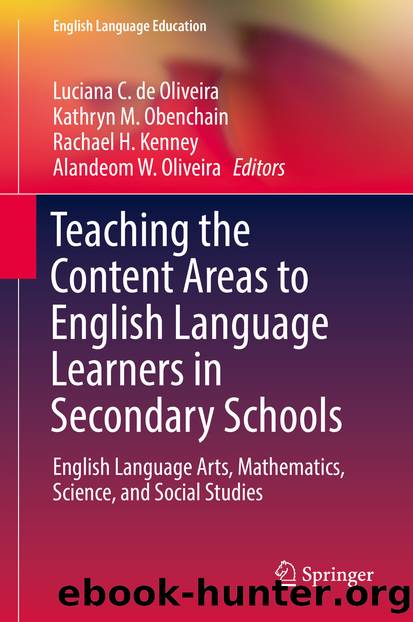Teaching the Content Areas to English Language Learners in Secondary Schools by Unknown

Author:Unknown
Language: eng
Format: epub
ISBN: 9783030022457
Publisher: Springer International Publishing
3.2 Knowledge and Skills of Linguistically Responsive Teachers
It is necessary to know about studentsâ lives outside of school in order to engage and effectively teach them (Lucas, 2011). Even though ELLs may receive support at school and be designated as English speakers of other languages (ESOL), they form heterogeneous groups. Regional differences can create diversity among students who share the same language background. Spanish-speakers, for example, use different vocabulary, phrases, and accents in Spain, the Caribbean, Mexico, North, Central, and South America; hence Spanish-speakers are extremely diverse. Teachers can interact with students in and outside of class, communicate with parents, and show interest in studentsâ well-being and life outside of school.
By anticipating and identifying the language demands of classroom instruction and assignments, teachers can scaffold ELLsâ content and language learning. The academic English needed to be successful in school goes beyond word-level vocabulary and includes specific grammar features at the sentence, paragraph, and text levels (Schleppegrell, 2004). A detailed analysis of curricula enables proactive planning and instruction that will better meet ELLsâ language and content-learning needs (Lucas, 2011).
There are four types of scaffolds that assist ELLs with content learning: (1) using extra-linguistic supports such as visuals, graphic organizers, hands-on activities, and/or alternate assignments that allow for drawing and use of pictures to present knowledge; (2) using supplemented/modified written text to include study guides, adapted or highlighted texts, notes, and/or summaries; (3) using supplemented/modified oral language to minimize idiomatic expressions, using the L1 to relay key concepts, taking time to explain key words and concepts, provide outlines, give examples, pausing more often, and repeating key concepts; and (4) providing clear and explicit instructions by listing steps for students to see on a board, asking students to repeat what they need to do in their own words, and including details in the instructions. For specific examples of how these principles can be applied to planning and teaching mathematics to ELLs, see Avalos, Medina, and Secada (2015).
By applying five key principles of L2 learning, teachers demonstrate they understand L2 acquisition processes and integrate those processes within instruction. Principle 1: Conversational language proficiency is fundamentally different from academic language proficiency. Though conversational language proficiency is important for every day interactions, both types of language proficiency are needed for school success (Lee, Quinn, & Valdés, 2013). Academic language proficiency generally takes longer for ELLs to develop; however, with L1 grade-level literacy proficiency, students will develop L2 academic language more quickly (Thomas & Collier, 2002).
Download
This site does not store any files on its server. We only index and link to content provided by other sites. Please contact the content providers to delete copyright contents if any and email us, we'll remove relevant links or contents immediately.
The Art of Coaching Workbook by Elena Aguilar(50038)
Trainspotting by Irvine Welsh(20940)
Twilight of the Idols With the Antichrist and Ecce Homo by Friedrich Nietzsche(18266)
Fangirl by Rainbow Rowell(8754)
Periodization Training for Sports by Tudor Bompa(7888)
Change Your Questions, Change Your Life by Marilee Adams(7319)
This Is How You Lose Her by Junot Diaz(6401)
Asking the Right Questions: A Guide to Critical Thinking by M. Neil Browne & Stuart M. Keeley(5319)
Grit by Angela Duckworth(5262)
Red Sparrow by Jason Matthews(5165)
Paper Towns by Green John(4752)
Room 212 by Kate Stewart(4703)
Ken Follett - World without end by Ken Follett(4410)
The Sports Rules Book by Human Kinetics(4042)
Housekeeping by Marilynne Robinson(4016)
Double Down (Diary of a Wimpy Kid Book 11) by Jeff Kinney(3873)
Papillon (English) by Henri Charrière(3870)
The Motorcycle Diaries by Ernesto Che Guevara(3754)
Exercise Technique Manual for Resistance Training by National Strength & Conditioning Association(3754)
